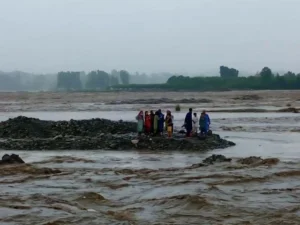Controlling Floods Now a Days: Modern Challenges and Solutions
Introduction:
Floods are among the most destructive natural disasters worldwide. With increasing urbanization, climate change, and extreme weather events, the urgency around controlling floods now a days has grown significantly. Traditional flood control methods are being reassessed, and new technologies and strategies are being developed to manage water more effectively. This article explores the current challenges in flood control and the modern solutions being used globally to combat this rising threat.

The Growing Challenge of Flooding
Floods can occur due to various reasons: heavy rainfall, storm surges, overflowing rivers, dam failures, or rapid snowmelt. Over the past few decades, several factors have intensified the risks and consequences associated with flooding:
-
Urbanization: Rapid and often unplanned urban expansion has led to the loss of natural drainage systems. Cities are covered with impervious surfaces like asphalt and concrete, which prevent water absorption and increase runoff.
-
Climate Change: Global warming is causing sea levels to rise and weather patterns to become more erratic. Intense storms and heavy rains are more frequent now than ever before.
-
Deforestation: Trees and vegetation play a crucial role in absorbing rainfall and reducing runoff. Deforestation leaves landscapes vulnerable to floods.
-
Aging Infrastructure: Many urban centers still rely on outdated drainage systems and levees that are no longer capable of handling the modern flood volumes.
As a result, controlling floods now a days requires more than just sandbags and dams — it demands innovation, planning, and global cooperation.
Traditional Flood Control Methods
Historically, the primary methods of flood control included:
-
Levees and Dikes: Barriers built to contain river overflow.
-
Reservoirs and Dams: Used to store excess water and regulate river flow.
-
Drainage Canals: Divert floodwaters away from populated areas.
-
Floodplains: Designated areas where excess water can safely spread out.
While these methods are still in use, their effectiveness is diminishing due to the scale and unpredictability of modern flooding events.
Modern Solutions for Controlling Floods
Today, engineers, urban planners, and governments are combining traditional methods with new technologies and policies. Here are some of the most promising approaches being implemented around the world.
1. Smart Flood Monitoring Systems
IoT (Internet of Things) devices and AI-powered sensors are now used to monitor water levels in real-time. These systems can predict floods hours or even days in advance, giving communities critical time to evacuate or reinforce defenses.
Example: The Netherlands uses a sophisticated flood warning system that collects data from sensors, satellites, and weather forecasts to manage the country’s vast water control infrastructure.
2. Sustainable Urban Drainage Systems (SUDS)
Instead of relying solely on underground pipes, SUDS manage rainfall on the surface. They include green roofs, permeable pavements, rain gardens, and bio-swales to absorb, slow down, and filter rainwater naturally.
Example: Singapore’s ABC Waters Program integrates water management with city planning, transforming concrete drains into beautiful parks and wetlands that also control floods.
3. Floodplain Restoration
Restoring natural floodplains allows rivers to overflow safely in designated areas. This not only reduces flood pressure downstream but also restores ecosystems.
Example: In Germany, parts of the Rhine River have had their floodplains restored, increasing their capacity to absorb water and reducing flood risk in nearby towns.
4. Managed Retreat and Zoning Laws
Some countries are moving populations away from high-risk flood zones. Zoning laws are being updated to prevent building in vulnerable areas.
Example: In the United States, FEMA has implemented “buyback” programs to purchase properties in high-flood areas, converting them into green spaces.
5. Coastal Barriers and Sea Walls
As sea levels rise, coastal cities are building massive barriers to prevent storm surges from inundating inland areas.
Example: Venice’s MOSE Project is a system of underwater gates that rise to block high tides from flooding the city.
6. Cloud Seeding and Weather Modification
Some regions are experimenting with weather modification to manage rainfall distribution. While still controversial and not widely adopted, cloud seeding can potentially prevent concentrated heavy rainfalls.

Policy and Community Involvement
Technology alone cannot solve the issue. Effective flood control now a days also involves public awareness, community involvement, and international cooperation.
-
Early Warning Education: Teaching communities how to respond when a flood warning is issued is critical for minimizing casualties and damage.
-
Integrated Water Resource Management (IWRM): Coordinated planning that considers all aspects of the water cycle — from source to sea — ensures sustainable solutions.
-
Insurance and Risk Financing: Governments are partnering with insurers to develop programs that help people recover financially from flood damage.
The Future of Flood Control
The future of controlling floods now a days lies in a combination of smart technology, sustainable planning, and global collaboration. As floods become more frequent and severe, adaptive management is key. Cities need to be “climate-resilient,” not just prepared for a single event, but equipped to handle continuous changes.
-
Digital Twins of Cities: Some governments are using digital models of cities to simulate floods and test different mitigation strategies before implementing them in real life.
-
Citizen Science: Apps and platforms are allowing citizens to report flooding, contributing to real-time data collection and response.
-
Nature-Based Solutions: Wetlands, mangroves, and forests are increasingly seen as cost-effective and sustainable flood barriers.
Conclusion
Controlling floods now a days is a complex but essential task in our changing world. From embracing green infrastructure and cutting-edge technology to updating policies and involving communities, a multi-pronged approach is necessary. By learning from both past and present innovations, societies can reduce the devastating impacts of flooding and build a safer, more resilient future.Wikipedia

